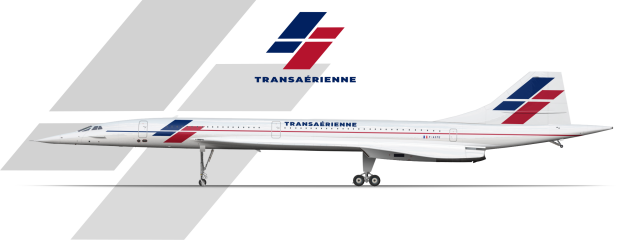Aerospatiale-BAC Concorde Transaérienne 1984-2003
- Owner: Rigel (View all images and albums)
- Uploaded: Mar 02 2024 11:22 AM
- Views: 295
- Album Transaérienne
Med + FlyHigh for template, everything else by Rigel with guidance from Edge

By the beginning of the 1990s, Transaérienne was looking to expand its own image. The merger with Mondiale had provided the new company with a host of long-haul routes, and a full fleet of aircraft to use them on, creating the larget privately-owned airline in France. Despite this, due to Transaérienne's previous system of solely regional and intra-European services, the name was still not well associated with the long-haul sector. In addition, the airline sought to further market its status as an airline fit for business travel, creating additional long-haul mainline services, considered separate from Transaérienne's leisure routes they were primarily known for. As a result, the company set about improving services to drum up attention on their long-range routes, introducing a new Business Class and First Class product to replace Mondiale's outdated products. However, the airline's eccentric CEO, Antoine Cartier, saw a unique opportunity to put the newly-enlarged airline on the map. The airline was about to make its most audacious business decision in its history.
Following years of mismanagement and poor financial decisions under government control, the British Royal Air Service was in dire straits in the years following the airline's privatisation. The airline was losing money year on year as a result of falling passenger numbers stemming from a sudden drop in quality of service in the late 70s, under the leadership of a strict, customer-unfriendly CEO who sought to cut costs wherever possible, leading to a series of in theory sensible, but in practice misguided alterations to the airline's service, which ultimately ended up driving passengers away. By 1989, the airline was millions in debt, and continually-falling passenger numbers meant the path towards bankruptcy was inevitable.
Ultimately, in 1990, BRAS was bought by, and merged into, the privately-owned Britannic Airways, which set about immediately making changes to fix the wrongs of the now-defunct airline, as well as to pay off its massive outstanding debt. Among these changes was the trimming of old, inefficient and overly expensive aircraft types. And central to this idea was BRAS' eight-strong subfleet of Concorde supersonic airliners.
While five of BRAS' eight Concordes would continue to operate with Britannic, the three that were let go of, G-BRAP, BRAR and BRAV, would be put up onto the market, and quickly bought by Transaérienne for $60 million each. The three aircraft would be re-registered F-ASTA, F-ASTC and F-ASTE respectively, and were quickly put into service on the airline's transatlantic routes between Paris and New York, inherited from Mondiale and primarily being flown with the airline's 747-200Cs. While the airline's Paris-Boston route was touted as a potential Concorde route, the demand for business travel (the primary customer base of Concorde) between the two cities was deemed not enough to justify the aircraft. Still, the Concorde service turned out to be a surprising success, bringing more business travel to the airline, and solidifying its image as a dependable, alternative way to travel long haul from Paris.
More Transaérienne Concorde lore to come soon.
Below: A poster showcasing Concordes of the British Royal Air Service and Transaérienne, as well as a list of the registrations the French airline inherited from the defunct British flag carrier.
Is the lore for this realistic at all? Probably not. Do I care? Not in the slightest.
Also, happy 55th anniversary since Concorde's first flight.
Leave feedback, is there is feedback to be left.

 Sign In
Sign In Create Account
Create Account












Interesting